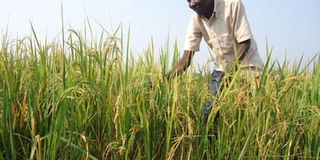Uganda exports more rice to South Sudan than other EAC countries

A rice farmer gathers a harvest from his field. Uganda exported more rice to South Sudan than any other country, according to the East African Trade report covering the 2020 second quarter. PHOTO | FILE
Uganda exported more rice to South Sudan than any other country, according to the East African Trade report covering the 2020 second quarter.
The exports and re-exports accounted for 68 per cent of rice exports to South Sudan from the period running between April and June.
During the period, according to the report, Uganda exported 31,411 metric tonnes [MT] of rice to South Sudan.
The rest was sourced from Tanzania, which contributed 21 and Somalia - 11 per cent.
“Uganda’s rice exports and re-exports to South Sudan increased due to the formal staple food cross border trade,” the report reads in part.
In 2018, Uganda had banned imports of rice to protect local farmers and boost the production.
A study then indicated that the rice market in Uganda had a daily milling capacity of 7,158 metric tonnes.
During the period, Uganda also exported other food items to South Sudan including beans.
For instance, Uganda exported 18,098 metric tonnes of dry beans to South Sudan while Kenya exported 11,136 metric tonnes.
Data from Bank of Uganda indicates that in the last 25 years (from 1994), formal beans export earnings have consistently grown at an annual average of 8.5 per cent, from $12.64m for 37,000 metric tonnes exported in 1994 to $99.6m for 218,000 metric tonnes in 2018.
The most significant growth, however, was in the five-year period to 2018 where export values grew from $25.12m to $99.6m.
That was a 32 per cent per annum growth over the five-year period. Data also indicates that less than 25 per cent of Uganda’s beans are exported.
Dry beans have progressively overtaken maize as the most informally exported commodity at Uganda’s borders.
For example, in 2018 dry beans worth $42.95m were traded informally, which was more than double the value of maize exported informally in the same year.
The East African Trade report, which projects the outlook of exportable commodities in East Africa also indicates that locally produced rice is projected to increase.




